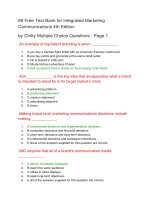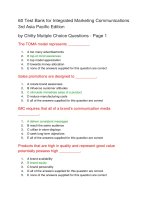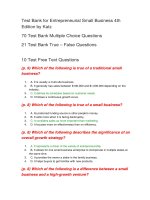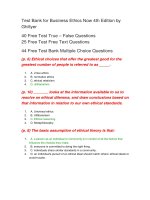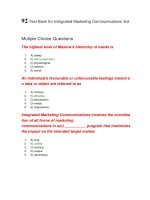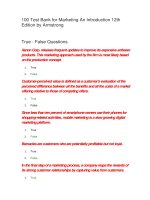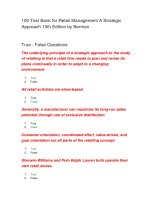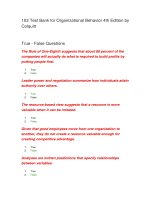141 test bank for integrated marketing communications 4th edition by chitty đề trắc nghiệm marketing
Bạn đang xem bản rút gọn của tài liệu. Xem và tải ngay bản đầy đủ của tài liệu tại đây (154.39 KB, 27 trang )
141 Test Bank for Integrated Marketing Communications 4th
Edition by Chitty
True - False Questions - Page 1
Brands perform a critical strategic role by providing a key
means for differentiating one company’s offering from
those of competing brands.
1.
2.
True
False
IMC does not require that all of a brand’s communication
media and messages deliver a consistent message.
1.
2.
True
False
The two types of decisions that need to be made when
developing a marketing communications program are
fundamental decisions and subsequent decisions.
1.
2.
True
False
Successful IMC requires that communication efforts be
directed at encouraging some form of investment.
1.
2.
True
False
Point-of-purchase communications are effective in creating
brand awareness, whereas mass media advertising
stimulates in-store brand selection.
1.
2.
True
False
Increased efforts to assess marketing communications’
return on investment constitute one of the reasons for
the shift towards IMC.
1.
2.
True
False
The goal of IMC is to affect the behaviour of the targeted
audience.
1.
2.
True
False
From the consumer’s perspective, accepted brands offer
assurances of consistent quality and performance,
thereby reducing risk associated with buying the
brand.
1.
2.
True
False
A ‘brand’ is a convenient (and appropriate) label for
describing only a single object of concerted marketing
efforts.
1.
2.
True
False
The trend over the past two decades has been to spend more
money on advertising and less on promotions.
1.
2.
True
False
The allocation of resources among various types of
marketing communications is categorised as an
implementation decision.
1.
2.
True
False
The primary objective of marketing communications is to
enhance brand equity and to move the customer to
take favourable action in relation to the brand.
1.
2.
True
False
Sales promotion is designed to create brand awareness.
1.
2.
True
False
Advertising is a form of person-to-person communication.
1.
2.
True
False
Positioning, targeting, setting objectives and budgeting are
all evaluative decisions.
1.
2.
True
False
The use of IMC is restricted to the mass media.
1.
2.
True
False
A brand has no equity if only a small number of customers
are familiar with it.
1.
2.
True
False
According to Keller, brand awareness is made up of brand
recall and brand image.
1.
2.
True
False
The goal of IMC is to directly influence employees’
perception of the brand.
1.
2.
True
False
The types of marketing communications chosen to market a
brand depend on the communication objectives of the
campaign.
1.
2.
True
False
Advertising consists of all the messages about the brand.
1.
2.
True
False
Advertising consists of all marketing activities that attempt
to stimulate quick buyer action or immediate sales of a
product.
1.
2.
True
False
A positioning statement is the key idea that encapsulates
what a brand is intended to stand for in its target
market’s mind.
1.
2.
True
False
The key feature of IMC planning is that it must start with
building relationships between the brand and the
customer.
1.
2.
True
False
The concept of brand equity is considered only from the
perspective of the customer.
1.
2.
True
False
Wasted coverage is avoided through targeting.
1.
2.
True
False
The objective of IMC is to reach the target audience
efficiently and effectively via one mass media avenue.
1.
2.
True
False
Marketing communications represents all the elements in a
brand’s marketing mix that facilitate exchanges by
establishing shared meaning with the brand’s
customers or clients.
1.
2.
True
False
A brand is a name, term, sign, symbol or design, or a
combination of these, that identifies the goods and
services of one seller or group of sellers and
differentiates them from those of competitors.
1.
2.
True
False
The positioning of the brand is an implementation decision
that needs to be made in the initial stages of the
marketing communications program.
1.
2.
True
False
IMC is a communications process that entails the planning,
creation, integration and implementation of diverse
forms of marketing communications that are delivered
over time to a brand’s targeted customers and
prospects.
1.
2.
True
False
All modern organisations use various forms of marketing
communications to promote their offerings.
1.
2.
True
False
Regardless of cost, mass media advertising will always be
the best approach for marketing a brand.
1.
2.
True
False
66 Free Test Bank for Integrated Marketing
Communications 4th Edition by Chitty True - False
Questions - Page 2
The marketing communications imperative is to move
brands from a state of unawareness to a state of
recognition, then to recall, and ultimately to top-ofmind awareness (TOMA).
1.
2.
True
False
Marketers are allocating a greater proportion of their
marketing communications budgets to interactive
social media, and reducing spending on some mass
media platforms.
1.
2.
True
False
The term ‘marketing communications’ represents the totality
of promotions.
1.
2.
True
False
Deciding on a campaign’s creative strategy is a fundamental
decision in the marketing communications program.
1.
2.
True
False
Establishing momentum is a critical strategy for new brands
entering the market place.
1.
2.
True
False
Implementation decisions that are part of a marketing
communications program are conceptual and
strategic.
1.
2.
True
False
All companies use marketing communications in some form
or another.
1.
2.
True
False
Point-of-purchase communications are the only influence on
consumer buying decisions at the point of purchase.
1.
2.
True
False
Brand recall reflects a relatively superficial level of
awareness, whereas brand recognition indicates a
deeper form of awareness.
1.
2.
True
False
The increased use of customer data by mainstream retailers
has allowed them to make business decisions that are
less intuitive.
1.
2.
True
False
A brand can leverage associations by connecting itself with
other brands, places, things and people.
1.
2.
True
False
Setting marketing communication objectives is unnecessary
for not-for-profit organisations.
1.
2.
True
False
Ethical changes to marketing communication practices have
been influential in changing traditional
communications practices and to the adoption of an
IMC approach.
1.
2.
True
False
In the automobile market, large competitors such as Toyota,
Holden and Ford have to spend a larger proportion of
their sales on advertising than smaller competitors
such as Hyundai, Daewoo and Mazda.
1.
2.
True
False
According to Keller, brand equity comprises brand
awareness and brand knowledge.
1.
2.
True
False
Marketing public relations does not involve non-personal
communications to a mass audience.
1.
2.
True
False
Inherent in the definition of IMC is the need for synergy.
1.
2.
True
False
One reason why it is extremely important to effectively
evaluate any marketing communications program is
the increasing demand for accountability in
organisational spending.
1.
2.
True
False
A brand’s position is the key feature, benefit or image that it
represents amongst its major competitors.
1.
2.
True
False
Co-branding occurs when two or more brands enter into a
partnership that potentially serves to enhance both
brands’ equity and profitability.
1.
2.
True
False
One of the major benefits of enhancing brand equity is that
consumer brand awareness will also increase.
1.
2.
True
False
Too much advertising and not enough promotion can
diminish a brand’s future value.
1.
2.
True
False
Fundamental decisions that are part of a marketing
communications program are practical and tactical.
1.
2.
True
False
IMC is a strategic process that integrates all the elements of
the promotional mix with the brand’s marketing mix, to
optimise short-term and long-term value of an
organisation’s brand.
1.
2.
True
False
The main types of marketing communications are
advertising, digital marketing communications, direct
marketing, sales promotion, personal selling,
sponsorship, marketing public relations and point-ofpurchase communications.
1.
2.
True
False
A potential downside for the host brand with respect to
ingredient branding is that it runs the risk of being
turned into a mere commodity.
1.
2.
True
False
It is easy to establish a brand that will become well known
and respected.
1.
2.
True
False
Most budgeting practices involve a combination of top-down
and all-over budgeting.
1.
2.
True
False
Although it is impossible to determine a mathematically
optimal mixture of advertising and promotion
expenditures, a satisfactory mixture can be formulated
by considering the different purposes of each of the
marketing communication tools.
1.
2.
True
False
Sales promotion attempt to stimulate buyer action or
immediate sales results, whereas advertising is
designed to accomplish communication objectives,
such as creating brand awareness and influencing
customer attitudes.
1.
2.
True
False
Digital marketing communications does not include social
media channels or search engine advertising.
1.
2.
True
False
Some brands have such exceptional brand equity that they
deserve the label ‘world-class’.
1.
2.
True
False
Marketing communications is not a critical component of
effective marketing.
1.
2.
True
False
Multiple Choice Questions - Page 1
.When two brands enter into an agreement that has the
potential to enhance the brand equity and profitability
of both brands, this is known as ____________.
1.
2.
3.
4.
5.
A.dual branding
B.dominant branding
C.equitable branding
D.co-branding
E.twin branding
.An implicit characteristic of IMC is the building of
relationships with customers. Which of the following
features is not a characteristic of relationship
building?
1.
2.
3.
4.
5.
A.repeat purchases
B.huge acquisition costs
C.enduring links between a brand and consumers
D.customer loyalty
E.None of the answers supplied for this question are correct.
.According to Keller, brand awareness comprises
____________.
1.
2.
3.
4.
5.
A.brand knowledge and brand experience
B.brand recognition and brand recall
C.brand knowledge and brand recall
D.brand equity and brand knowledge
E.None of the answers supplied for this question are correct.
.The practice of promoting the interests of a company and its
brands by associating with a specific event is known
as ____________.
1.
2.
3.
4.
5.
A.sales promotion
B.publicity
C.point-of-purchase communications
D.advertising
E.sponsorship marketing
.Fundamental marketing communication decisions include
____________.
1.
2.
3.
4.
A.positioning, mixing elements, budgeting and setting objectives
B.targeting, budgeting, evaluating and planning
C.positioning, evaluating, planning and forecasting
D.positioning, targeting, setting objectives and budgeting
5.
E.None of the answers supplied for this question are correct.
.Making brand-level marketing communications decisions
include making ____________.
1.
2.
3.
4.
5.
A.fundamental decisions and implementation decisions
B.evaluation decisions and financial decisions
C.short-term decisions and long-term decisions
D.fundamental decisions and subsequent decisions
E.None of the answers supplied for this question are correct.
.Sales promotions are designed to ____________.
1.
2.
3.
4.
5.
A.create brand awareness
B.influence customer attitudes
C.stimulate immediate sales of a product
D.reduce manufacturing costs
E.All of the answers supplied for this question are correct.
.In general, the single-voice, or synergy, principle involves
selecting a specific ____________ for a brand.
1.
2.
3.
4.
5.
A.positioning statement
B.marketing mix
C.pricing strategy
D.advertising budget
E.None of the answers supplied for this question are correct.
.According to the brand awareness pyramid, consumers
begin by being ____________.
1.
2.
3.
4.
5.
A.aware of the brand
B.true to the brand
C.unaware of the brand
D.not sure of the brand
E.skeptical of the brand
.Using different forms of marketing communications,
communications’ basic objective is to ____________.
1.
2.
3.
4.
5.
A.facilitate the successful introduction of new brands
B.improve corporate relations with special interest groups
C.create good publicity
D.increase customer loyalty
E.All of the answers supplied for this question are correct.
.Advertising ____________.
1.
2.
A.is a form of person-to-person communication
B.consists of all marketing activities that attempt to stimulate quick buyer action
3.
C.consists of all marketing activities that attempt to stimulate immediate sales of a
product
4. D.often assumes the form of news items
5. E.involves direct communication that is pinpointed to each B2B customer or
ultimate consumer
.IMC starts with profiling the ____________.
1.
2.
3.
4.
5.
A.manufacturer
B.wholesaler
C.retailer
D.customer
E.competitors
.IMC requires that all of a brand’s communication media
____________.
1.
2.
3.
4.
5.
A.deliver consistent messages
B.reach the same audience
C.utilise in-store displays
D.seek long-term objectives
E.All of the answers supplied for this question are correct.
.The goal of establishing successful relationships between
customers and brands is to generate ____________.
1.
2.
3.
4.
5.
A.customer loyalty
B.increased revenues
C.synergy
D.brand equity
E.None of the answers supplied for this question are correct.
.The marketing mix for a brand consists of ____________.
1.
2.
3.
4.
5.
A.product
B.price
C.promotion
D.place
E.All of the answers supplied for this question are correct.
.According to Keller, brand knowledge comprises
____________.
1.
2.
3.
4.
5.
A.brand equity and brand image
B.brand equity and brand communications
C.brand awareness and brand image
D.brand awareness and brand loyalty
E.brand awareness and brand advertising
.An example of ingredient branding is when ____________.
1.
A.you buy a Qantas flight ticket with an American Express credit card
2.
3.
4.
5.
B.you buy petrol and groceries at the same retail outlet
C.ink is placed in a Bic pen
D.Nicole Kidman advertises Chanel
E.Dell computers have a sticker on them saying ‘Intel Inside’
.The goal of IMC is to ____________.
1.
2.
3.
4.
5.
A.increase brand awareness
B.affect the behaviour of the targeted audience
C.learn how to outsell the competition
D.lower production costs
E.All of the answers supplied for this question are correct.
.The basic dimension of brand equity is ____________.
1.
2.
3.
4.
5.
A.brand image
B.brand associations
C.brand personality
D.brand awareness
E.All of the answers supplied for this question are correct.
.IMC ____________.
1.
2.
3.
4.
5.
A.is limited to the use of mass media
B.starts with identifying the major competitors
C.strives to achieve synergy
D.has the main objective of increasing brand awareness
E.All of the answers supplied for this question are correct.
.A form of person-to-person communication would be
____________.
1.
2.
3.
4.
5.
A.advertising
B.sales promotion
C.personal selling
D.promotion
E.None of the answers supplied for this question are correct.
.The notion that all elements of the marketing mix must be
coordinated and that all must speak with one voice is
called ____________.
1.
2.
3.
4.
5.
A.micromarketing
B.integrated marketing communications
C.the marketing concept
D.the promotion concept
E.the single-voice theory of communications
.Some brands have such an exceptional ____________ that
they deserve to be known as ‘world-class’ brands.
1.
2.
3.
4.
5.
A.brand equity
B.design
C.innovation
D.market share
E.shareholders
.Initially, the marketing communication program involves
making ____________.
1.
2.
3.
4.
5.
A.fundamental decisions and budgeting decisions
B.fundamental decisions and implementation decisions
C.implementation decisions and evaluation decisions
D.financial decisions and evaluation decisions
E.None of the answers supplied for this question are correct.
.A(n) ____________ is the key idea that encapsulates what a
brand is intended to stand for in its target market’s
mind.
1.
2.
3.
4.
5.
A.advertising platform
B.positioning statement
C.mission statement
D.advertising objective
E.vision
.According to the brand awareness pyramid, top-of-mind
awareness (TOMA) comes directly after consumers
____________.
1.
2.
3.
4.
5.
A.recognise the brand
B.buy the brand
C.recall the brand
D.trial the brand
E.None of the answers supplied for this question are correct.
.Marketing communications implementation decisions
include ____________.
1.
2.
3.
4.
5.
A.mixing elements, creating messages, selecting media and establishing
momentum
B.creating messages, planning media and evaluating responses
C.designing advertisements, pre-testing advertisements and evaluating responses
to advertisements
D.mixing elements, creating messages, selecting media and evaluating responses
E.none of the answers supplied for this question are correct
.The most important requirement for successful co-branding
is that the brands possess ____________.
1.
2.
3.
4.
5.
A.a common budget
B.a common manufacturing base
C.a common fit
D.a common country of origin
E.None of the answers supplied for this question are correct.
.For the firms that market them, brands play a key role in
____________.
1.
2.
3.
A.achieving economies of scale by producing a brand in mass quantity
B.creating barriers to entry for competitors who want to introduce their own brands
C.providing a key means for differentiating one company’s offering from
competitive brands
4. D.enabling a manufacturer to gain leverage vis-á-vis retailers and other marketing
intermediaries
5. E.All of the answers supplied for this question are correct.
.The process whereby thoughts are conveyed and meaning
is shared between individuals or between
organisations and individuals is known as
____________.
1.
2.
3.
4.
5.
A.communication
B.marketing
C.personal selling
D.exchanging
E.promotion
.The TOMA model represents ____________.
1.
2.
3.
4.
5.
A.too many advertisements
B.top-of-mind awareness
C.top model appreciation
D.towards money allocation
E.None of the answers supplied for this question are correct.
.The adoption of IMC necessitates ____________.
1.
2.
3.
4.
5.
A.increased faith in mass media advertising
B.decreased reliance on highly targeted communication methods
C.greater demands imposed on communication suppliers
D.decreased efforts to assess communications’ return on investment
E.None of the answers supplied for this question are correct.
.A ____________ is a name, term, sign, symbol or design, or
a combination of these, intended to identify the goods
and services of one seller or group of sellers and to
differentiate them from those of competitors.
1.
2.
3.
4.
5.
A.brand
B.market
C.tradename
D.trademark
E.guarantee
.When a brand has strong, favourable and unique
associations in consumers’ minds, this is an example
of ____________.
1.
2.
3.
4.
5.
A.brand equity
B.brand personality
C.brand dimensions
D.brand associations
E.brand value
.Products that are high in quality and represent good value
potentially possess high ____________.
1.
2.
3.
4.
5.
A.brand availability
B.brand equity
C.brand personality
D.All of the answers supplied for this question are correct.
E.None of the answers supplied for this question are correct.
69 Free Test Bank for Integrated Marketing
Communications 4th Edition by Chitty Multiple
Choice Questions - Page 2
.Fundamental marketing communications involves making
decisions about ____________.
1.
2.
3.
4.
5.
A.targeting
B.positioning
C.campaign objectives
D.budgets
E.All of the answers supplied for this question are correct.
.A brand’s ____________ represents the key feature, benefit,
or image that it stands for in the target audience’s
collective mind.
1.
A.equity
2.
3.
4.
5.
B.image
C.position
D.name
E.trademark
.The term ‘integrated marketing communications’ includes
all the major types of ____________.
1.
2.
3.
4.
5.
A.marketing communications
B.advertising
C.traditional marketing communications
D.mass media
E.sales promotions
.Systematic decision making requires the message content
in advertisements or promotions, on packages or at
events to be predicated on the brand’s ____________
strategy.
1.
2.
3.
4.
5.
A.IMC
B.marketing
C.objective
D.budgeting
E.positioning
.It has been said that marketing and communications
____________.
1.
2.
3.
4.
5.
A.are virtually inseparable
B.require total organisation effort
C.are difficult to monitor in a competitive environment
D.produce rewarding return on investment
E.None of the answers supplied for this question are correct.
.Anne is asked by a market researcher to tell him the
particular thoughts and feelings she has about UWS
libraries. A particular thought or feeling that comes to
Anne’s mind is known as a(n) ____________.
1.
2.
3.
4.
5.
A.brand dimension
B.cognition
C.brand link
D.association
E.think–feel linkage
.When the NutraSweet logo is included on the packaging of
brands such as Diet Coke, this is an example of
____________.
1.
2.
3.
4.
5.
A.ingredient branding
B.co-operative branding
C.brand equity
D.brand endorsements
E.All of the answers supplied for this question are correct.
.Which of the following is a source by which brand meaning
can be leveraged?
1.
2.
3.
4.
5.
A.other brands
B.places
C.things
D.people
E.All of the answers provided for this question are correct.
.World-class brands possess high brand equity because they
are well known and possess strong and favourable
____________ in consumers’ minds.
1.
2.
3.
4.
5.
A.consumer products
B.brand association
C.service provision
D.brand personality
E.market share
.The following events have been influential in changing
marketing communication practices:
1.
2.
3.
4.
5.
A.increased reliance on billboard advertising
B.decreased usage of highly targeted communication methods
C.greater competitive environment in luxury goods
D.increased efforts to invest in brand’s recall strategies
E.None of the answers supplied for this question are correct.
.An example of co-branding is when ____________.
1.
2.
3.
4.
5.
A.you buy a Qantas flight ticket with an American Express credit card
B.you buy petrol and groceries at the same retail outlet
C.ink is placed in a Bic pen
D.Nicole Kidman wears Chanel
E.None of the answers supplied for this question are correct.
.Before consumers recognise the brand they must
____________.
1.
A.be aware of the brand
2.
3.
4.
5.
B.buy the brand
C.recommend the brand
D.go to the shopping mall
E.None of the answers supplied for this question are correct.
.May is asked by a market researcher to list all the brands of
toothpaste she can think of. Which type of awareness
is this assessing?
1.
2.
3.
4.
5.
A.recall
B.recognition
C.positive awareness
D.free-association awareness
E.aided recognition
.The term or concept ‘media’ applies to which marketing
communications tool?
1.
2.
3.
4.
5.
A.advertising
B.public relations
C.promotions
D.personal selling
E.all of these choices
.A marketing communication objective is ____________.
1.
2.
3.
4.
5.
A.to improve market share
B.to reward shareholders
C.to expand the sales force
D.to make the brand the envy of the market place
E.None of the answers supplied for this question are correct.
.Profiling a target market involves____________.
1.
2.
3.
4.
5.
A.collecting competitor’s information
B.analysing past purchase orders
C.determining their lifestyles
D.selecting the most suitable statistical method
E.None of the answers supplied for this question are correct.
.The trend over the last two decades has been to spend
____________.
1.
2.
3.
4.
5.
A.more on billboards and less on movie advertising
B.more on advertising and less on promotions
C.more on promotions and less on advertising
D.less on both advertising and promotions
E.more on both advertising and promotions
.The increasing demand for accountability means that
____________ is very important.
1.
2.
3.
4.
5.
A.branding
B.program evaluation
C.objective setting
D.advertising
E.direct mailing
.By far the most frequently used budgeting method is
____________, especially in firms where marketing
departments have greater influence than finance units.
1.
2.
3.
4.
5.
A.top-down (TD)
B.bottom-up (BU)
C.top-down/bottom-up/top-down (TDBUTD)
D.bottom-up/top-down (BUTD)
E.top-down/bottom-up (TDBU)
.Key features of IMC include ____________.
1.
2.
3.
4.
5.
A.profiling the target market and using the relevant media
B.achieving communication synergy
C.building customer relationships
D.influencing the target market’s behaviour
E.All of the answers supplied for this question are correct.
.Database marketing is an integral part of direct marketing
because it provides companies with information that
allows them to profile their customers and to
____________.
1.
2.
3.
4.
5.
A.establish long-term relationships
B.expand their market share
C.increase add-on sales
D.set their advertising budget
E.lower production costs
.The way to create favourable, strong and unique brand
associations is through ____________.
1.
2.
3.
4.
5.
A.brand image
B.brand personality
C.marketing communications
D.brand equity
E.None of the answers supplied for this question are correct.
.What is the initial challenge for new brands?
1.
A.achieving brand awareness
2.
3.
4.
5.
B.enhancing brand image
C.achieving brand preference
D.achieving brand insistence
E.building revenue premium
.Fundamental marketing communications decisions are
____________, while implementation decisions are
____________.
1.
2.
3.
4.
5.
A.conceptual; strategic
B.conceptual; practical
C.practical; tactical
D.tactical; conceptual
E.practical; conceptual
.Marketing communicators ____________ meaning and
create associations for their brands by connecting
them with other objects that already possess wellknown meaning.
1.
2.
3.
4.
5.
A.promote
B.locate
C.leverage
D.advertise
E.obtain
.Program evaluation is accomplished by ____________.
1.
2.
A.developing a budget that is based on marketing communications objectives
B.comparing budgeted marketing communications expenditures against share-ofvoice
3. C.collecting data on consumers’ demographics and lifestyles
4. D.developing a guiding structure within the fundamental decisions
5. E.measuring the results of marketing communications effort against the objectives
that were established
.The new Myer Visa card is an example of ____________.
1.
2.
3.
4.
5.
A.ingredient branding
B.personality branding
C.retail branding
D.co-branding
E.services branding
.The objective of marketing communications is to enhance
brand equity as a means of ____________.
1.
2.
3.
A.defining the marketing mix
B.increasing consumer brand loyalty
C.increasing short-term sales
4.
5.
D.reducing the advertising budget
E.reducing the promotional budget
.Jenny went into a jeweller’s shop to look at the watches, but
she was unfamiliar with some of the brands. The
salesperson told her that they were all Swiss-made,
meaning they were made in Switzerland, which is
known worldwide for the quality of the timepieces
produced there. From which source are these brands
leveraging their brand meaning?
1.
2.
3.
4.
5.
A.other brands
B.people
C.places
D.things
E.names
.It is important that all the elements of the marketing
communication mix are integrated to achieve an
organisation’s marketing communication objectives
and to enhance the organisation’s ____________.
1.
2.
3.
4.
5.
A.market share
B.return on investments
C.brand equity
D.shareholders’ value
E.marketing mix
.Spending on digital marketing communications –
particularly mobile advertising – is increasing, while
spending on ____________ is static.
1.
2.
3.
4.
5.
A.market research
B.mass marketing communications
C.packaging
D.direct marketing
E.point-of-purchase communication
.____________ allows marketing communicators to deliver
messages more precisely and to prevent wasted
coverage to people falling outside the intended
audience.
1.
2.
3.
4.
A.Segmenting
B.Setting objectives
C.Positioning
D.Targeting
5.
E.Momentum
.The word ____________ refers to an object’s force or speed
of movement.
1.
2.
3.
4.
5.
A.drive
B.push
C.momentum
D.force
E.pull
.Brand meaning can be leveraged by ____________.
1.
2.
3.
4.
5.
A.employees
B.endorsers
C.alliances
D.All of the answers supplied for this question are correct.
E.None of the answers supplied for this question are correct.
Free Text Questions
Debra is the brand manager for Tide laundry detergent,
marketed by Procter & Gamble, and she is making the
brand-level fundamental decisions in the marcom
decision process. Discuss what she will be
considering.
Answer Given
The fundamental decisions in the brand-level marcom decision process include: 1.
Targeting. Targeting allows marketing communicators to deliver messages more
precisely and to prevent wasted coverage to people falling outside the intended
audience. Selection of target segments is a critical step toward effective and
efficient marketing communications. Companies identify potential target markets in
terms of demographic characteristics, lifestyles, product usage patterns and
geographic considerations. Meaningful market segments generally represent
consumers who share a combination of characteristics and demonstrate similar
behavior; 2. Positioning. A brand’s position represents the key feature, benefit, or
image that it stands for in the target audience’s collective mind. Debra must decide
on Tide’s positioning statement, which is the central idea that encapsulates the
brand’s meaning and distinctiveness vis-á-vis competitive brands in the laundry
detergent category; 3. Setting objectives. Marketing communicators’ decisions are
grounded in the underlying goals, or objectives, to be accomplished for a brand; 4.
Budgeting. Financial resources are budgeted to specific marcom elements to
accomplish desired objectives. Different budgeting methods include top-down
budgeting (TD), bottom-up budgeting (BU), or a combination of the two (BUTD or
TDBU).
Compare and contrast the terms ‘promotion’ and ‘marketing
communications’, and list the primary tools of
marketing communications.
Answer Given
The ‘4P’ characterisation of marketing has led to widespread use of the term
promotion for describing communications with prospects and customers. However,
the term marketing communications is preferred by most marketing practitioners
as well as many educators and is the term used to refer to the collection of
advertising, sales promotion, public relations, event marketing and other
communication devices; comparatively, the text uses the term promotions as a
shorthand reference to sales promotions. The primary tools of marketing
communications include media advertising (e.g. TV, radio, magazines,
newspapers), direct response and interactive advertising (e.g. direct mail,
telephone solicitation, online advertising), place advertising (e.g. billboards and
bulletins, posters, transit ads, cinema ads), store signage and point-of-purchase
advertising (e.g. external store signs, in-store shelf signs, shopping cart ads, instore radio and TV), trade- and consumer-oriented promotions (e.g., trade deals
and buying allowances, display and advertising allowances, trade shows,
cooperative advertising, samples, coupons, premiums, refunds/rebates,

